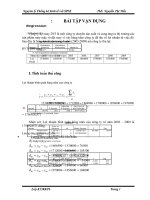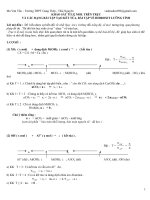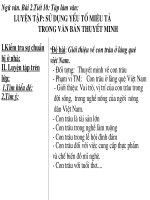Bài tập chương 4 – rủi ro thị trường market risk analysis (1)
Bạn đang xem bản rút gọn của tài liệu. Xem và tải ngay bản đầy đủ của tài liệu tại đây (333.45 KB, 9 trang )
Bài tạp chuong 4 – Rui ro thi truơng Market Risk Analysis
1. What is meant by market risk?
Market risk is the uncertainty of the effects of changes in economywide systematic
factors that affect earnings and stock prices of different firms in a similar manner. Some
of these marketwide risk factors include volatility, liquidity, interestrate and
inflationary expectation changes.
2.
Why is the measurement of market risk important to the manager of a financial
institution?
Measurement of market risk can help an FI manager in the following ways:
a. Provide information on the risk positions taken by individual traders.
b. Establish limit positions on each trader based on the market risk of their
portfolios.
c. Help allocate resources to departments with lower market risks and appropriate
returns.
d. Evaluate performance based on risks undertaken by traders in determining
optimal bonuses.
e. Help develop more efficient internal models so as to avoid using standardized
regulatory models.
3.
What is meant by daily earnings at risk (DEAR)? What are the three measurable
components? What is the price volatility component?
DEAR or Daily Earnings at Risk is defined as the estimated potential loss of a portfolio's
value over a oneday unwind period as a result of adverse moves in market conditions,
such as changes in interest rates, foreign exchange rates, and market volatility. DEAR is
comprised of (a) the dollar value of the position, (b) the price sensitivity of the assets to
changes in the risk factor, and (c) the adverse move in the yield. The product of the price
sensitivity of the asset and the adverse move in the yield provides the price volatility
component.
Follow Bank has a $1 million position in a fiveyear, zerocoupon bond with a face value
of $1,402,552. The bond is trading at a yield to maturity of 7.00 percent. The
historical mean change in daily yields is 0.0 percent, and the standard deviation is
12 basis points.
a. What is the modified duration of the bond?
MD = 5 ÷ (1.07) = 4.6729 years
b.
What is the maximum adverse daily yield move given that we desire no
more than a 5 percent chance that yield changes will be greater than this maximum?
Potential adverse move in yield at 5 percent = 1.65 = 1.65 x 0.0012 = .001980
c. What is the price volatility of this bond?
Price volatility = MD x potential adverse move in yield
= 4.6729 x .00198 = 0.009252 or 0.9252 percent
d. What is the daily earnings at risk for this bond?
DEAR = ($ value of position) x (price volatility)
= $1,000,000 x 0.009252 = $9,252
5. How can DEAR be adjusted to account for potential losses over multiple days? What
would be the VAR for the bond in problem 4 for a 10day period? What statistical
assumption is needed for this calculation? Could this treatment be critical?
The DEAR can be adjusted to account for losses over multiple days using the formula N
day VAR = DEAR x [N]½ , where N is the number of days over which potential loss is
estimated. Nday VAR is a more realistic measure when it requires a longer period for an
FI to unwind a position, that is, if markets are less liquid. The value for the 10day VAR
in problem 4 above is $13,065 x [10]½ = $41,315.
According to the above formula, the relationship assumes that yield changes are
independent and daily volatility is approximately constant. This means that losses
incurred one day are not related to losses incurred the next day. Recent studies have
indicated that this is not the case, but that shocks are autocorrelated in many markets over
long periods of time.
6. In what sense is duration a measure of market risk?
The market risk calculations typically are based on the trading portion of an FIs fixedrate
asset portfolio because these assets must reflect changes in value as market interest rates
change. As such, duration or modified duration provides an easily measured and usable
link between changes in the market interest rates and the market value of fixedincome
asset
7. Bank Alpha has an inventory of AAArated, 15year zerocoupon bonds with a face
value of $400 million. The bonds currently are yielding 9.5% in the overthe
counter market.
a. What is the modified duration of these bonds?
Modified duration = (MD) = D/(1 + r) = 15/(1.095) = 13.6986.
b. What is the price volatility if the potential adverse move in yields is 25 basis
points?
Price volatility = (MD) x (potential adverse move in yield)
= (13.6986) x (.0025) = 0.03425 or 3.425 percent.
c. What is the DEAR?
Daily earnings at risk (DEAR) = ($ Value of position) x (Price volatility)
Dollar value of position = 400/(1 + 0.095)15 = $102.5293million. Therefore,
DEAR = $102.5293499 million x 0.03425 = $3.5116 million, or $3,511,630.
d.
If the price volatility is based on a 90 percent confidence limit and a mean
historical change in daily yields of 0.0 percent, what is the implied standard deviation
of daily yield changes?
The potential adverse move in yields (PAMY) = confidence limit value x standard
deviation value. Therefore, 25 basis points = 1.65 x , and = .0025/1.65 = .
001515 or 15.15 basis points.
8. Bank Two has a portfolio of bonds with a market value of $200 million. The bonds
have an estimated price volatility of 0.95 percent. What are the DEAR and the 10
day VAR for these bonds?
Daily earnings at risk (DEAR)
= ($ Value of position) x (Price volatility)
= $200 million x .0095
= $1.9million, or $1,900,000
Value at risk (VAR)
= DEAR x N = $1,900,000 x 10
= $1,900,000 x 3.1623 = $6,008,327.55
9. Bank of Ayers Rock’s stock portfolio has a market value of $10 000 000. The beta of
the portfolio approximates the market portfolio, whose standard deviation (σm) has been
estimated at 1.5 per cent. What is the 5day VaR of this portfolio, using adverse rate
changes in the 99th percentile
DEAR = ($ Value of portfolio) x (2.33 x m ) = $10m x (2.33 x .015)
= $10m x .03495 = $0.3495m or $349,500
VAR = $349,500 x 5 = $349,500 x 2.2361 = $781,505.76
11. Calculate the DEAR for the following portfolio with and without the correlation
coefficients.
12. What are the advantages of using the back simulation approach to estimate market
risk? Explain how this approach would be implemented.
The advantages of the back simulation approach to estimating market risk are that (a) it is
a simple process, (b) it does not require that asset returns be normally distributed, and (c)
it does not require the calculation of correlations or standard deviations of returns.
Implementation requires the calculation of the value of the current portfolio of assets
based on the prices or yields that were in place on each of the preceding 500 days (or
some large sample of days). These data are rankordered from worst case to best and
percentile limits are determined. For example, the five percent worst case provides an
estimate with 95 percent confidence that the value of the portfolio will not fall more than
this amount.
13. Export Bank has a trading position in Japanese Yen and Swiss Francs. At the close of
business on February 4, the bank had ¥300,000,000 and Sf10,000,000. The exchange
rates for the most recent six days are given below:
a. What is the foreign exchange (FX) position in dollar equivalents using the FX
rates on February 4?
Japanese Yen: ¥300,000,000/¥112.13 = $2,675,465.98
Swiss Francs: Swf10,000,000/Swf1.414 = $7,072,135.78
b.
What is the definition of delta as it relates to the FX position?
Delta measures the change in the dollar value of each FX position if the foreign
currency depreciates by 1 percent against the dollar.
c.
What is the sensitivity of each FX position; that is, what is the value of
delta for each currency on February 4?
Japanese Yen: 1.01 x current exchange rate
= 1.01 x ¥112.13 = ¥113.2513/$
Revalued position in $s
= ¥300,000,000/113.2513 =
$2,648,976.21
Delta of $ position to Yen = $2,648,976.21 $2,675,465.98
= $26,489.77
Swiss Francs: 1.01 x current exchange rate
= 1.01 x Swf1.414 = Swf1.42814
Revalued position in $s
= Swf10,000,000/1.42814 =
$7,002,114.64
Delta of $ position to Swf = $7,002,114.64 $7,072,135.78
= $70,021.14
d. What is the daily percentage change in exchange rates for each currency over the
fiveday period?
Day
2/4
100
2/3
2/2
2/1
1/29
Japanese Yen:
0.62921%
Swiss Franc
0.24691% % Change = (Ratet/Ratet1) 1 *
0.62422%
2.52934%
1.11732%
0.02579%
0.29718%
0.59084%
0.42382%
0.24074%
e.
What is the total risk faced by the bank on each day? What is the worst
case day? What is the bestcase day?
Japanese Yen Swiss Francs
Total
Day
Delta
% Rate
Risk
Delta
% Rate
Risk
Risk
2/4 $26,489.77 0.6292% $166.68 $70,021.14 0.2469% $172.88
$339.56
2/3 $26,489.77 0.6242% $165.35 $70,021.14 0.2972% $208.10 $373.45
2/2 $26,489.77 2.5293% $670.01 $70,021.14 0.5908% $413.68 $1,083.69
2/1 $26,489.77 1.1173% $295.97 $70,021.14 0.4238% $296.75
$0.78
1/29 $26,489.77 0.0258% $6.83 $70,021.14 0.2407% $168.54 $175.37
The worstcase day is February 3, and the bestcase day is February 2.
f. Assume that you have data for the 500 trading days preceding February 4.
Explain how you would identify the worstcase scenario with a 95 percent
degree of confidence?
The appropriate procedure would be to repeat the process illustrated in part (e)
above for all 500 days. The 500 days would be ranked on the basis of total risk
from the worstcase to the bestcase. The fifth percentile from the absolute worst
case situation would be day 25 in the ranking.
g.
Explain how the five percent value at risk (VAR) position would be
interpreted for business on February 5.
Management would expect with a confidence level of 95 percent that the total risk
on February 5 would be no worse than the total risk value for the 25th worst day in
the previous 500 days. This value represents the VAR for the portfolio.
h.
How would the simulation change at the end of the day on February 5?
What variables and/or processes in the analysis may change? What variables and/or
processes will not change?
The analysis can be upgraded at the end of the each day. The values for delta may
change for each of the assets in the analysis. As such, the value for VAR may also
change.
14. What is the primary disadvantage to the back simulation approach in measuring
market risk? What affect does the inclusion of more observation days have as a
remedy for this disadvantage? What other remedies are possible to deal with the
disadvantage?
The primary disadvantage of the back simulation approach is the confidence level
contained in the number of days over which the analysis is performed. Further, all
observation days typically are given equal weight, a treatment that may not reflect
accurately changes in markets. As a result, the VAR number may be biased upward or
downward depending on how markets are trending. Possible adjustments to the analysis
would be to give more weight to more recent observations, or to use Monte Carlo
simulation techniques
15. How is Monte Carlo simulation useful in addressing the disadvantages of back
simulation? What is the primary statistical assumption underlying its use?
Monte Carlo simulation can be used to generate additional observations that more closely
capture the statistical characteristics of recent experience. The generating process is
based on the historical variancecovariance matrix of FX changes. The values in this
matrix are multiplied by random numbers that produce results that pattern closely the
actual observations of recent historic experience
16. What is the difference between VAR and expected shortfall (ES) as measure of
market risk? VAR corresponds to a specific point of loss on the probability distribution.
It does not provide information about the potential size of the loss that exceeds it, i.e.,
VAR completely ignores the patterns and the severity of the losses in the extreme tail.
Thus, VAR gives only partial information about the extent of possible losses, particularly
when probability distributions are nonnormal. The drawbacks of VAR became painfully
evident during the financial crisis as asset returns plummeted into the “fat tail” region of
nonnormally shaped distributions. FIs managers and regulators were forced to recognize
that VAR projections of possible losses far underestimated actual losses on extreme bad
days. Expected shortfall (ES), also referred to as conditional VAR and expected tail loss,
is a measure of market risk that estimates the expected value of losses beyond a given
confidence level, i.e., it is the average of VARs beyond a given confidence level. ES,
which incorporates points to the left of VAR, is larger when the probability distribution
exhibits fat tail losses. Accordingly, ES provides more information about possible market
risk losses than VAR. For situations in which probability distributions exhibit fat tail
losses, VAR may look relatively small, but ES may be very large.
17. onsider the following discrete probability distribution of payoffs for
two securities, A and B, held in the trading portfolio of an FI:
Which of the two securities will add more market risk to the FI’s trading
portfolio according to the VaR and ES measures?
The expected return on security A = 0.50($80m) + 0.49($60m) + 0.01(-$740m) = $62m
The expected return on security B = 0.50($800m) + 0.49($68m) + 0.0040(-$740m) +
0.0060(-$1393m) = $62m
For a 99% confidence level, VARA = VARB = -$740m
For a 99% confidence level, ESA = -$740m, while ESB = 0.40(-$740m) + 0.60(-$1393m)
= -$1,131.8m
18. Consider the following discrete probability distribution of payoffs for two securities,
A and B, held in the trading portfolio of an FI:
The expected return on security A = 0.55($120m) + 0.44($95m) + 0.01(-$1,100m) =
$96.8m
The expected return on security B = 0.55($120m) + 0.44($100m) + 0.0030(-$1,100m) +
0.0070(-$1,414m) = $96.8m
For a 99% confidence level, VARA = VARB = -$1,100m
For a 99% confidence level, ESA = -$1,100m, while ESB = 0.30(-$1,100m) + 0.70($1,414m) = -$1,319.8m
Thus, while the VAR is identical for both securities, the ES finds that security B has the
potential to subject the FI to much greater losses than security A. Specifically, if
tomorrow is a bad day, VAR finds that there is a 1 percent probability that the FI’s losses
will exceed $1,100 million on either security. However, if tomorrow is a bad day, ES
finds that there is a 1 percent probability that the FI’s losses will exceed $1,100 million if
security A is in its trading portfolio, but losses will exceed $1,319.8m if security B is in
its trading portfolio.
20. An FI has ¥500 million in its trading portfolio on the close of business on a particular
day. The current exchange rate of yen for dollars is ¥80.00/$, or dollars for yen is
$0.0125, at the daily close. The volatility, or standard deviation (σ), of daily percentage
changes in the spot ¥/$ exchange rate over the past year was 121.6 bp. The FI is
interested in adverse moves – bad moves that will not occur more than 1 percent of the
time, or 1 day in every 100. Calculate the one-day VAR and ES from this position.
The first step is to calculate the dollar value position:
Dollar value of position = yen value of position x dollar for pound exchange rate = ¥500
million x 0.0125 = $6,250,000
Using VAR, which assumes that changes in exchange rates are normally distributed, the
exchange rate must change in the adverse direction by 2.33σ (2.33 x 121.6 bp) for this
change to be viewed as likely to occur only 1 day in every 100 days:
FX volatility = 2.33 x 121.6 bp = 283.328 bp
In other words, using VAR during the last year the yen declined in value against the
dollar by 283.328 bp 1 percent of the time. As a result, the one-day VAR is:
VAR = $6,250,000 x 0.0283328 = $177,080
Using ES, which assumes that changes in exchange rates are normally distributed but
with fat tails, the exchange rate must change in the adverse direction by 2.665σ (2.665 x
121.6 bp) for this change to be viewed as likely to occur only 1 day in every 100 days:
FX volatility = 2.665 x 121.6 bp = 324.064 bp
In other words, using ES during the last year the yen declined in value against the dollar
by 324.064 bp 1 percent of the time. As a result, the one-day ES is:
ES = $6,250,000 x 0.0324064 = $202,540
The potential loss exposure to adverse yen to dollar exchange rate changes for the FI
from the ¥500 million spot currency holdings are higher using the ES measure of market
risk. ES estimates potential losses that are $25,460 higher than VAR. This is because
VAR focuses on the location of the extreme tail of the probability distribution. ES also
considers the shape of the probability distribution once VAR is exceeded.
21. The Bank of Canberra’s stock portfolio has a market value of $250 million. The beta
of the portfolio approximates the market portfolio, whose standard deviation (σm) has
been estimated at 2.25 per cent. What are the five-day VaR and ES of this portfolio using
adverse rate changes in the 99th percentile?
Daily VAR = ($ value of portfolio) x (2.33 x σm ) = $250m x (2.33 x 0.0225) = $250m x
0.052425 = $13,106,250
5-day VAR = $13,106,250 x √5 = $13,106,250 x 2.2361 = $29,306,466
Daily ES = ($ value of portfolio) x (2.665 x σm ) = $250m x (2.665 x 0.0225) = $250m x
0.0599625 = $14,990,625
5-day ES = $14,990,625 x √5 = $14,990,625 x 2.2361 = $33,520,057









